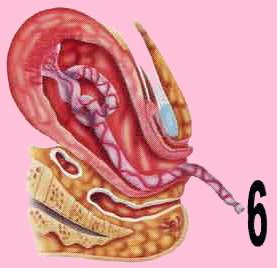الجوهرة المصونة
*****




المشاركات : 17164
العمـر : 36
تعاليق : مشرفة الطب والصحة
المزاج : 
الدولة : 
المهنة : 
الهواية : 
التسجيل : 10/10/2008
النقاط : 18248
التقييم : 501

 
توفيقك يارب

 |  موضوع: الولادة الطبيعية (normal delivery)والقيصرية بالصـور موضوع: الولادة الطبيعية (normal delivery)والقيصرية بالصـور  الإثنين ديسمبر 21, 2009 9:07 pm الإثنين ديسمبر 21, 2009 9:07 pm | |
| هذة صور نادرة نقدمها لكم لترو لحظات الولادة
بما يصاحبها من الم وتوجع
بس الحمد الله بعدها يطلع احلى طفل يملاء قلبها فرح
هيا نرى بالخطوات والشرح طريقة
الوضع ( معجزة الهية )تتكرر مرار بينا بشتى الطرق
1 - يبـدأ رأس الطفل بالتقدم نحو فتحة الحوض
تأخذ هذه العملية اسابيع ( عند الولادة الاولى للام )
أو ساعات للام ذات ( ولادات سابقه )

2- تتقلص عضلات الرحم وبشكل منتظم
وذلك يؤدي إلى تفجر الغشاء الجنيني وخروج السائل

3 -تحدث إنقباضات متكررة للرحـم ( الطلق ) تقريبا كل عشر دقائق
ويصاحبه توسع في عنق الرحـم 1 سنتمتر تقريبا كل ساعة
حتى يصل 10 سم لتسهيل خروج الطفل
عندها تبدأ التقلصات في عضلات الرحم تزداد في القوة لدفع الطفل خارجاَ
(المرحلة الأطول في الولادة الطبيعية )

4 - يخرج رأس الطفل أولا
إذا لم يحدث أن التوسع كان كاملا
عندها من الضروري اللجوء لشق العجان ( الفرج )

5 - بعد خروج الرأس يلتف جسم الطفل ويبدأ في الخروج
طول هذه المرحلة نسبة إلى جميع الأمهات متغيرة

6 - بعد خروج الطفل من رحم الأم
يظل متصلاَ إلى المشيمة عن طريق الحبل السري والذي لابد من قطعه
اما المشيمة وماتبقى معها تضل داخل رحم الام

7 - يحصل انقباض قوي للعضلات الرحمية
لطرد الحبل السري والمشيمة مع الأمور المتبقية إلى الخارج
تقريبا عشر دقائق بعد الولادة

8 - بطرد الحبل السري والمشيمة تنتهي الولادة

وبعد كذا شهر من ولادة هالقمر وفرحتة اللى بتنسى الام الااام الولادة والحمل بالتسع شهور
يكبر هالبيبى ويكون قمر متل هذا
Normal Labor and Delivery
Definition
Labor is a physiologic process during which the products of conception (ie, the fetus, membranes, umbilical cord, and placenta) are expelled outside of the uterus. Labor is achieved with changes in the biochemical connective tissue and with gradual effacement and dilatation of the uterine cervix as a result of rhythmic uterine contractions of sufficient frequency, intensity, and duration.1,2
Labor is a clinical diagnosis. The onset of labor is defined as regular, painful uterine contractions resulting in progressive cervical effacement and dilatation. Cervical dilatation in the absence of uterine contraction suggests cervical insufficiency, whereas uterine contraction without cervical change does not meet the definition of labor.
Stages of Labor and Epidemiology
Stages of Labor
Obstetricians have divided labor into 3 stages that delineate milestones in a continuous process.
First stage of labor
The first stage begins with regular uterine contractions and ends with complete cervical dilatation at 10 cm. In Friedman's landmark studies of 500 nulliparas3 , he subdivided the first stage into an early latent phase and an ensuing active phase. The latent phase begins with mild, irregular uterine contractions that soften and shorten the cervix. The contractions become progressively more rhythmic and stronger. This is followed by the active phase of labor, which usually begins at about 3-4 cm of cervical dilation and is characterized by rapid cervical dilation and descent of the presenting fetal part. The first stage of labor ends with complete cervical dilation at 10 cm. According to Friedman, the active phase is further divided into an acceleration phase, a phase of maximum slope, and a deceleration phase.
Characteristics of the average cervical dilatation curve is known as the Friedman labor curve, and a series of definitions of labor protraction and arrest were subsequently established.4,5 However, subsequent data of modern obstetric population suggest that the rate of cervical dilatation is slower and the progression of labor may be significantly different from that suggested by the Friedman labor curve.6,7,8
Second stage of labor
The second stage begins with complete cervical dilatation and ends with the delivery of the fetus. The AmericanCollege of Obstetricians and Gynecologists (ACOG) has suggested that a prolonged second stage of labor should be considered when the second stage of labor exceeds 3 hours if regional anesthesia is administered or 2 hours in the absence of regional anesthesia for nulliparas. In multiparous women, such a diagnosis can be made if the second stage of labor exceeds 2 hours with regional anesthesia or 1 hour without it.1
Studies performed to examine perinatal outcomes associated with a prolonged second stage of labor revealed increased risks of operative deliveries and maternal morbidities but no differences in neonatal outcomes.9,10,11,12 Maternal risk factors associated with a prolonged second stage include nulliparity, increasing maternal weight and/or weight gain, use of regional anesthesia, induction of labor, fetal occiput in a posterior or transverse position, and increased birthweight.11,12,13,14
Third stage of labor
The third stage of labor is defined by the time period between the delivery of the fetus and the delivery of the placenta and fetal membranes. During this period, uterine contraction decreases basal blood flow, which results in thickening and reduction in the surface area of the myometrium underlying the placenta with subsequent detachment of the placenta.15 Although delivery of the placenta often requires less than 10 minutes, the duration of the third stage of labor may last as long as 30 minutes.
Expectant management of the third stage of labor involves spontaneous delivery of the placenta. Active management often involves prophylactic administration of oxytocin or other uterotonics (prostaglandins or ergot alkaloids), early cord clamping/cutting, and controlled cord traction of the umbilical cord. A systematic review of the literature that included 5 randomized controlled trials comparing active and expectant management of the third stage reports that active management shortens the duration of the third stage and is superior to expectant management with respect to blood loss/risk of postpartum hemorrhage; however, active management is associated with an increased risk of unpleasant side effects.16
The third stage of labor is considered prolonged after 30 minutes, and active intervention, such as manual extraction of the placenta, is commonly considered.2
Epidemiology
As the childbearing population in the United States has changed, the clinical obstetric management of labor also has evolved since Friedman's studies. Data from number a studies have suggested that normal labor can progress at a rate much slower than that Friedman and Sachtleben4,5 had described. Zhang et al examined the labor progression of 1,162 nulliparas who presented in spontaneous labor and constructed a labor curve that was markedly different from Friedman's: The average interval to progress from 4-10 cm of cervical dilatation was 5.5 hours compared with 2.5 hours of Friedman's labor curve.17 Kilpatrick et al6 and Albers et al7 also reported that the median lengths of first and second stages of labor were longer than those Friedman suggested.
A number of investigators have identified several maternal characteristics obstetric factors that are associated with the length of labor. One group reported that increasing maternal age was associated with a prolonged second stage but not first stage of labor.18
While nulliparity is associated with a longer labor compared to multiparas, increasing parity does not further shorten the duration of labor.19 Some authors have observed that the length of labor differs among racial/ethnic groups. One group reported that Asian women have the longest first and second stages of labor compared with Caucasian or African American women20 , and American Indian women had second stages shorter than those of non-Hispanic Caucasian women.7 However, others report conflicting findings.21,22 Differences in the results may have been due to variations in study designs, study populations, labor management, or statistical power.
In one large retrospective study of the length of labor, specifically with respect to race and/or ethnicity, the authors observed no significant differences in the length of the first stage of labor among different racial/ethnic groups. However, the second stage was shorter in African American women than in Caucasian women for both nulliparas (-22 min) and multiparas (-7.5 min). Hispanic nulliparas, compared with their Caucasian counterparts, also had a shortened second stage, whereas no differences were seen for multiparas. In contrast, Asian nulliparas had a significantly prolonged second stage compared with their Caucasian counterparts, and no differences were seen for multiparas.23
Mechanism of Labor
The ability of the fetus to successfully negotiate the pelvis during labor involves changes in position of its head during its passage in labor. The mechanisms of labor, also known as the cardinal movements, are described in relation to a vertex presentation, as is the case in 95% of all pregnancies. Although labor and delivery occurs in a continuous fashion, the cardinal movements are described as 7 discrete sequences, as discussed below.2
Engagement
The widest diameter of the presenting part (with a well-flexed head, where the largest transverse diameter of the fetal occiput is the biparietal diameter) enters the maternal pelvis to a level below the plane of the pelvic inlet. On the pelvic examination, the presenting part is at 0 station, or at the level of the maternal ischial spines.
Descent
The downward passage of the presenting part through the pelvis. This occurs intermittently with contractions. The rate is greatest during the second stage of labor.
Flexion
As the fetal vertex descents, it encounters resistance from the bony pelvis or the soft tissues of the pelvic floor, resulting in passive flexion of the fetal occiput. The chin is brought into contact with the fetal thorax, and the presenting diameter changes from occipitofrontal (11.0 cm) to suboccipitobregmatic (9.5 cm) for optimal passage through the pelvis.
Internal rotation
As the head descends, the presenting part, usually in the transverse position, is rotated about 45° to anteroposterior (AP) position under the symphysis. Internal rotation brings the AP diameter of the head in line with the AP diameter of the pelvic outlet.
Extension
With further descent and full flexion of the head, the base of the occiput comes in contact with the inferior margin of the pubic symphysis. Upward resistance from the pelvic floor and the downward forces from the uterine contractions cause the occiput to extend and rotate around the symphysis. This is followed by the delivery of the fetus' head.
Restitution and external rotation
When the fetus' head is free of resistance, it untwists about 45° left or right, returning to its original anatomic position in relation to the body.
Expulsion
After the fetus' head is delivered, further descent brings the anterior shoulder to the level of the pubic symphysis. The anterior shoulder is then rotated under the symphysis, followed by the posterior shoulder and the rest of the fetus. | |
|
الجوهرة المصونة
*****




المشاركات : 17164
العمـر : 36
تعاليق : مشرفة الطب والصحة
المزاج : 
الدولة : 
المهنة : 
الهواية : 
التسجيل : 10/10/2008
النقاط : 18248
التقييم : 501

 
توفيقك يارب

 |  موضوع: رد: الولادة الطبيعية (normal delivery)والقيصرية بالصـور موضوع: رد: الولادة الطبيعية (normal delivery)والقيصرية بالصـور  الإثنين ديسمبر 21, 2009 9:11 pm الإثنين ديسمبر 21, 2009 9:11 pm | |
| | |
|
حورية البحر
*****




المشاركات : 25046
العمـر : 54
المزاج : 
الدولة : 
المهنة : 
الهواية : 
التسجيل : 02/09/2009
النقاط : 30698
التقييم : 645
 |  موضوع: رد: الولادة الطبيعية (normal delivery)والقيصرية بالصـور موضوع: رد: الولادة الطبيعية (normal delivery)والقيصرية بالصـور  الثلاثاء ديسمبر 22, 2009 9:46 pm الثلاثاء ديسمبر 22, 2009 9:46 pm | |
| اول مره بقرأ هل المعلومات يسلمو كتير بحث أكتر من رآآآآآئع وبوضح الفكرة
دامت أناملك تخط لنا ابداعات مستمرة غاليتي جوهرة | |
|
عاشقة الزهور
*****




المشاركات : 75737
العمـر : 41
المزاج : 
الدولة : 
المهنة : 
الهواية : 
التسجيل : 09/03/2009
النقاط : 101796
التقييم : 846
 |  موضوع: رد: الولادة الطبيعية (normal delivery)والقيصرية بالصـور موضوع: رد: الولادة الطبيعية (normal delivery)والقيصرية بالصـور  الأربعاء ديسمبر 23, 2009 3:18 pm الأربعاء ديسمبر 23, 2009 3:18 pm | |
| موضوع قيم ومهم ومفيد للغاية
يعطيكي الف عاااااااافية يارب
| |
|
الجوهرة المصونة
*****




المشاركات : 17164
العمـر : 36
تعاليق : مشرفة الطب والصحة
المزاج : 
الدولة : 
المهنة : 
الهواية : 
التسجيل : 10/10/2008
النقاط : 18248
التقييم : 501

 
توفيقك يارب

 |  موضوع: رد: الولادة الطبيعية (normal delivery)والقيصرية بالصـور موضوع: رد: الولادة الطبيعية (normal delivery)والقيصرية بالصـور  الأربعاء ديسمبر 23, 2009 10:28 pm الأربعاء ديسمبر 23, 2009 10:28 pm | |
| يسلمو حورية البحر
عاشقة الزهور
لمروركما العطر
| |
|





